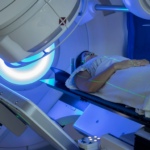Radiation therapy is an effective treatment that uses high-energy rays to kill prostate cancer cells. Radiation therapy may be used depending on prostate cancer’s stage and other variables.
Types of radiation therapy
The main types of radiation therapy used for prostate cancer are:
- External beam radiation
- Brachytherapy (internal radiation)
- Radiopharmaceuticals (medicines containing radiation that are injected into the body)
External beam radiation therapy (EBRT)
This is the most popular and painless form of radiation therapy. Your radiation team will utilise magnetic resonance imaging (MRI) and computed tomography (CT) images to identify the prostate and tumor cells before treatment.
X-ray beams are concentrated on the targeted cancer areas during each treatment session.
The targeted cancerous spots are the focus of the X-ray beams employed in each treatment session. To better administer high doses of radiation to tumor cells while delivering lower doses to nearby healthy tissues, oncologists can alter the strength of doses and radiation beams.
Three-dimensional conformal radiation therapy (3D-CRT)
The location of your prostate is accurately mapped utilising 3D-CRT by using specialist computers. The risk of harm to nearby healthy tissue and organs is then decreased by shaping and directing radiation beams at the prostate from a variety of angles.
Intensity-modulated radiation therapy (IMRT)
IMRT, an advanced form of 3D-CRT therapy, is the most common type of external beam radiation therapy for prostate cancer. It uses a computer-driven machine that moves around the patient as it delivers radiation. Along with shaping the beams and aiming them at the prostate from several angles, the intensity (strength) of the beams can be adjusted to limit the doses of radiation reaching nearby normal tissues. This lets doctors deliver an even higher radiation dose to cancer.
Stereotactic body radiation therapy (SBRT)
This technique uses advanced image-guided techniques to deliver large doses of radiation to a precise area, such as the prostate. Because there are large doses of radiation in each dose, the entire course of treatment is given over just a few days.
SBRT is often known by the names of the machines that deliver the radiation, such as Gamma Knife, X-Knife, CyberKnife, and Clinac.
Proton beam radiation therapy
Proton beam therapy focuses beams of protons instead of x-rays on cancer. Unlike x-rays, which release energy before and after they hit their target, protons cause little damage to tissues they pass through and release their energy only after traveling a certain distance. This means that proton beam radiation can, in theory, deliver more radiation to the prostate while doing less damage to nearby normal tissues. Proton beam radiation can be aimed with techniques similar to 3D-CRT and IMRT.
Brachytherapy (internal radiation therapy)
Brachytherapy (also called seed implantation or interstitial radiation therapy) uses small radioactive pellets, or “seeds,” each about the size of a grain of rice. These pellets are placed directly into your prostate.
- Brachytherapy is generally used only in men with early-stage prostate cancer that is relatively slow growing (low-grade).
- Brachytherapy combined with external radiation is sometimes an option for men with a higher risk of cancer growing outside the prostate.
Permanent (low dose rate, or LDR) brachytherapy
Temporary (high dose rate, or HDR) brachytherapy
Radiopharmaceuticals
Radiopharmaceuticals are drugs that contain radioactive elements. They are injected into a vein and travel through the blood to reach cancer cells that have spread to other body parts. These drugs then give off radiation that kills the cancer cells. (The type of radiation they use travels only a short distance, which helps limit side effects.) Unlike other types of radiation, these drugs can reach cancer anywhere in the body.
Radiopharmaceuticals that target PSMA
Radiopharmaceuticals that target the bones




